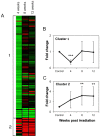Effect of irradiation on cell transcriptome and proteome of rat submandibular salivary glands
- PMID: 22792391
- PMCID: PMC3391292
- DOI: 10.1371/journal.pone.0040636
Effect of irradiation on cell transcriptome and proteome of rat submandibular salivary glands
Abstract
Salivary glands (SGs) are irreversibly damaged by irradiation (IR) treatment in head and neck cancer patients. Here, we used an animal irradiation model to investigate and define the molecular mechanisms affecting SGs following IR, focusing on saliva proteome and global transcription profile of submandibular salivary gland (SSG) tissue.We show that saliva secretion was gradually reduced to 50% of its initial level 12 weeks post-IR. Saliva protein composition was further examined by proteomic analysis following mass spectrometry (MS) analysis that revealed proteins with reduced expression originating from SSGs and proteins with increased expression derived from the serum, both indicating salivary tissue damage. To examine alterations in mRNA expression levels microarray analysis was performed. We found significant alterations in 95 genes, including cell-cycle arrest genes, SG functional genes and a DNA repair gene.Tissue damage was seen by confocal immunofluorescence of α-amylase and c-Kit that showed an increase and decrease, respectively, in protein expression. This was coherent with real-time PCR results.This data indicates that IR damages the SSG cells' ability to produce and secrete saliva and proteins, and maintain the physiological barrier between serum and saliva. The damage does not heal due to cell-cycle arrest, which prevents tissue regeneration. Taken together, our results reveal a new insight into IR pathobiology.
Conflict of interest statement
Figures




Similar articles
-
Secretion of saliva in X-irradiated rat submandibular glands.Radiat Res. 2003 Mar;159(3):351-60. doi: 10.1667/0033-7587(2003)159[0351:sosixi]2.0.co;2. Radiat Res. 2003. PMID: 12600238
-
Proteomic analysis of secretion from human transplanted submandibular gland replacing lacrimal gland with severe keratoconjunctivitis sicca.Biochim Biophys Acta. 2012 Apr;1824(4):550-60. doi: 10.1016/j.bbapap.2012.01.011. Epub 2012 Jan 28. Biochim Biophys Acta. 2012. PMID: 22306964
-
Irradiation-induced damage to the salivary glands: the role of redox-active iron and copper.Radiat Res. 1997 Apr;147(4):468-76. Radiat Res. 1997. PMID: 9092927
-
Abnormally high levels of cystatin S in submandibular glands, saliva, and gingiva of plaque-resistant rats.J Dent Res. 1998 Nov;77(11):1913-9. doi: 10.1177/00220345980770110801. J Dent Res. 1998. PMID: 9823730
-
Effect of photic stimuli on rat salivary glands. Role of sympathetic nervous system.Acta Odontol Latinoam. 2000;13(1):3-19. Acta Odontol Latinoam. 2000. PMID: 11885465 Review.
Cited by
-
Long-term Pilocarpine Treatment Improves Salivary Flow in Irradiated Mice.Acta Histochem Cytochem. 2019 Jun 25;52(3):45-58. doi: 10.1267/ahc.19006. Epub 2019 Jun 19. Acta Histochem Cytochem. 2019. PMID: 31341340 Free PMC article.
-
A prediction model for xerostomia in locoregionally advanced nasopharyngeal carcinoma patients receiving radical radiotherapy.BMC Oral Health. 2022 Jun 17;22(1):239. doi: 10.1186/s12903-022-02269-0. BMC Oral Health. 2022. PMID: 35715856 Free PMC article. Clinical Trial.
-
Effect of Previous Irradiation on Vascular Thrombosis of Microsurgical Anastomosis: A Preclinical Study in Rats.Plast Reconstr Surg Glob Open. 2016 Nov 23;4(11):e1073. doi: 10.1097/GOX.0000000000001073. eCollection 2016 Nov. Plast Reconstr Surg Glob Open. 2016. PMID: 27975009 Free PMC article.
References
-
- Vokes EE, Weichselbaum RR, Lippman SM, Hong WK. Head and neck cancer. N Engl J Med. 1993;328:184–194. - PubMed
-
- Konings AW, Coppes RP, Vissink A. On the mechanism of salivary gland radiosensitivity. Int J Radiat Oncol Biol Phys. 2005;62:1187–1194. - PubMed
-
- Fox PC. Acquired salivary dysfunction. Drugs and radiation. Ann N Y Acad Sci. 1998;842:132–137. - PubMed
-
- Aframian DJ, Cukierman E, Nikolovski J, Mooney DJ, Yamada KM, et al. The growth and morphological behavior of salivary epithelial cells on matrix protein-coated biodegradable substrata. Tissue Eng. 2000;6:209–216. - PubMed
-
- Aframian DJ, David R, Ben-Bassat H, Shai E, Deutsch D, et al. Characterization of murine autologous salivary gland graft cells: a model for use with an artificial salivary gland. Tissue Eng. 2004;10:914–920. - PubMed
Publication types
MeSH terms
Substances
LinkOut - more resources
Full Text Sources

